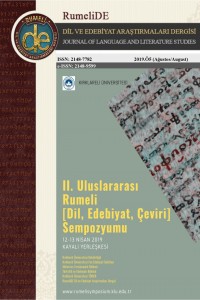Öz
Turkish is a language used in Asia, Europe and
Africa for various reasons. A wide range of Turkish, especially the European
countries wanted to be better recognized by the countries, so they recorded the
Turkish language in the Latin alphabet. Other than the alphabets used by
Turkish, especially the Latin and Cyrillic alphabets recorded with the text of
the transcription and this type of works called the first text Codex Cumanicus.
Later on, many such works were written. Jean CHs. Abrégé de la Grammaire in
Budapest, 1829, published by De Besse on 1829 and published in Budapest in
1829, published by Turco et Hongrois. and Turkish grammar book written in
French. Turkey and especially Istanbul to recognize, the facilities of Istanbul
has prepared for those who want to exploit. This work consists of 14 chapters
and subdivisions. After the 14th chapter there are vocabulary. The thematic
path was followed here. The topics and the order of the work are as follows:
Chapter 1 (1-7. P.) Alphabet and pronunciation, Turkish alphabet, Reading
examples; Parts of speech (section 2); Chapter 3 (7-8. P.) Names; Chapter 4
(8-10 p.) Adjectives; Chapter 5 (10-12. P.) Numbers; Chapter 6 (12-17. P.)
Personal pronouns, possessive, sign pronoun, pronoun, question pronoun,
unquestionable pronoun; Chapter 7 (17-19. P.) Generally refers to verbs;
Chapter 8 (19-46) p. Is an auxiliary verb, being an auxiliary verb, not being a
negative verb, active verbs of first conjunctions, negative verbs, active verbs
of second conjunctions, passive verbs, irregular verbs; Chapter 9 (46-47. P.)
Adjective verbs; Prepositions of Chapter 10 (47-49); Chapter 11 (49-53. P.)
Envelopes; Chapter 7 (53. p.) Connectors; Chapter (53-54) p. Chapter 14
(54-143. P.) Syntax, Turkish idioms, dialogues, country and city names, names
of some nations, river names, mountain names, names of celestial bodies, anasir-i
erbaa, celestial events, time and season names names of days of the week,
haysiyet in Sultam's inner courtyard, French, Turkish and Hungarian dictionary,
Turkish, French and Hungarian dictionary. This work, which treats the
vocabulary of the era as thematic and comparative, draws attention especially
with the title of idiotism. The vocabulary, which is listed as idiotism, is the
subject of the study and its determinations will be made.
Anahtar Kelimeler
Kaynakça
- Besse, J. C. (1829). Abrégé de la grammaire turque : contenant, outre les principes de cette langue, des idiotismes, des discours familiers, et un petit vocabulaire en français, turc et hongrois. Pest : O. Wigand. De Besse, J.-C. (1838). Voyage en Crimée, au Caucase, en Géorgie, en Arménie, en Asie-Mineure et à Constantinople en 1829 et 1830, . Paris: Delaunay. Parastatov, S., & Kondrasheva, A. (2018). Academic studies of the black sea region and the northwest caucasus (second half of the 18th to the early 19th century),. D. Gutmeyr, & K. Kaser içinde, Europe and the Black Sea Region A History of Early Knowledge Exchange (1750-1850); (s. 313-335). Zurich: Verlag.
Öz
Türkçe, çeşitli sebeplerle Asya, Avrupa ve
Afrika’da kullanılmış bir dildir. Özellikle Avrupa ülkeleri tarafından daha iyi
tanınmak istenmiş, bu sebeple Türkçeyi Latin alfabesiyle kaydetmişlerdir.
Türkçede kullanılan alfabeler dışında, özellikle Latin ve Kiril alfabeleriyle
kayda geçirilen ve transkripsiyon metni adı verilen bu tür eserlerin ilki Codex
Cumanicus’tur. Daha sonra bu tarzda çok sayıda eser yazılmıştır. Jean CHs.
De Besse tarafından 5 Ocak 1829’da tamamlanan ve 1829 tarihinde Budapeşte’de
basılan Abrégé de la Grammaire Turque Contenant Outre le Principe de Cette
Langue, des Idiotismes, des Dicours Familiers et un Petit Vocabulaire en
Français, Turc et Hongrois adlı eser Macarca ve Fransızca yazılan Türkçe
bir gramer kitabıdır. Türkiye’yi ve özellikle İstanbul’u tanımak, İstanbul’un
imkanlarından istifade etmek isteyenler için hazırlandığı belirtilen bu eser 14
bölüm ve bu bölümlere bağlı alt bölümlerden oluşur. 14. bölümden sonra söz
varlığı vardır. Burada tematik yol izlenmiştir. Eserin içerdiği konular ve
sırası şöyledir: 1. bölüm (1-7. s.) alfabe ve
telaffuz, Türk alfabesi, okuma örnekleri; 2. bölüm (7. s.) konuşmanın
bölümleri; 3. bölüm (7-8. s.) isimler; 4. bölüm (8-10. s.) sıfatlar; 5. bölüm
(10-12. s.) sayılar; 6. bölüm (12-17. s.) şahıs zamirleri, iyelik, işaret
zamiri, ki zamiri, soru zamiri, belirsiz zamir; 7. bölüm (17-19. s.) genel
olarak fiiller; 8. bölüm (19-46. s.) yardımcı fiil vardır, yardımcı
fiil olmak, olumsuz fiil olmamak, İlk bağlaçların aktif fiilleri, olumsuz fiiller, ikinci bağlaçların aktif
fiilleri, pasif fiiller, düzensiz fiiller; 9. bölüm (46-47. s.) sıfat fiiller;
10. bölüm (47-49. s.) edatlar; 11. bölüm (49-53. s.) zarflar; 12. bölüm (53.
s.) bağlaçlar; 13. bölüm (53-54. s.) ünlemler; 14. bölüm (54-143. s.) söz
dizimi, Türkçe deyimler, diyaloglar, ülke ve
şehir adları, bazı milletlerin adları, nehir adları, dağ adları, gök
cisimlerinin adları, anasır-ı erbaa, gök olayları, zaman ve mevsim adları,
haftanın günlerinin adları, Fransızca, Türkçe ve Macarca sözlük, Türkçe,
Fransızca ve Macarca sözlük. Devrinin söz varlığını tematik ve karşılaştırmalı
olarak ele alan bu eser, özellikle idyotizm başlığıyla dikkatleri çeker.
İdyotizm adıyla sıralan söz varlığı çalışmanın konusu olup nitelikleri üzerinde
tespitlerde bulunulacaktır.
Kaynakça
- Besse, J. C. (1829). Abrégé de la grammaire turque : contenant, outre les principes de cette langue, des idiotismes, des discours familiers, et un petit vocabulaire en français, turc et hongrois. Pest : O. Wigand. De Besse, J.-C. (1838). Voyage en Crimée, au Caucase, en Géorgie, en Arménie, en Asie-Mineure et à Constantinople en 1829 et 1830, . Paris: Delaunay. Parastatov, S., & Kondrasheva, A. (2018). Academic studies of the black sea region and the northwest caucasus (second half of the 18th to the early 19th century),. D. Gutmeyr, & K. Kaser içinde, Europe and the Black Sea Region A History of Early Knowledge Exchange (1750-1850); (s. 313-335). Zurich: Verlag.
Ayrıntılar
| Birincil Dil | Türkçe |
|---|---|
| Konular | Dilbilim |
| Bölüm | Türk dili, kültürü ve edebiyatı |
| Yazarlar | |
| Yayımlanma Tarihi | 21 Ağustos 2019 |
| Yayımlandığı Sayı | Yıl 2019 - RumeliDE 2019.Ö5 - II. Rumeli [Dil, Edebiyat, Çeviri] Sempozyumu Bildirileri |


